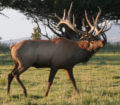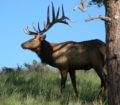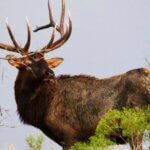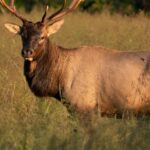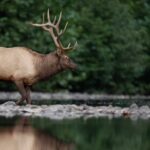Editor’s Note: Ralph Ramos from Las Cruces, New Mexico, is an elk guide, Ramos teaches a different form of elk calling – aggressive calling that’s had proven success. This week we’ll learn how to get ready for elk season, and why Ramos calls the way he calls. To get John and Denise Phillips’ free cookbook, “Miz Denise’s Outdoor Cooking: More than 35 Recipes for Elk and Mule Deer,” go to https://johninthewild.com/free-books. Too, you can learn about John’s other available elk books at https://johninthewild.com/books. Also, you can look forward to John’s latest elk book, available July 1, 2018, titled, “Elk: Keys to 25 Hunters’ Success.”
 About 25-years ago, I had an opportunity to hunt with Larry D. Jones in the Gila National Forest near Reserve, New Mexico (https://www.fs.usda.gov/gila). At the first of the season, the weather was really hot, and the elk weren’t bugling. We sat down for lunch, and Larry said, “Let’s start sounding like two bulls up here on the top of this mountain. Let’s bugle back and forth like bull elk challenging each other. In the middle of bugling, let’s start giving some cow calls. Then we can sound like a whole herd of elk, because we know there’s elk in this area.” So, Larry and I bugled back and forth when we were within 25 yards of each other. Larry would bugle off to his right, and I would bugle off to my left, and we mixed in numbers of calf and cow calls. In-between our calling, we’d stop and listen. Across the draw from where we’d been calling, we heard a bull start chuckling about 400-yards away. We kept up our excessive calling. Within about 4 minutes, that bull came in to where we were.
About 25-years ago, I had an opportunity to hunt with Larry D. Jones in the Gila National Forest near Reserve, New Mexico (https://www.fs.usda.gov/gila). At the first of the season, the weather was really hot, and the elk weren’t bugling. We sat down for lunch, and Larry said, “Let’s start sounding like two bulls up here on the top of this mountain. Let’s bugle back and forth like bull elk challenging each other. In the middle of bugling, let’s start giving some cow calls. Then we can sound like a whole herd of elk, because we know there’s elk in this area.” So, Larry and I bugled back and forth when we were within 25 yards of each other. Larry would bugle off to his right, and I would bugle off to my left, and we mixed in numbers of calf and cow calls. In-between our calling, we’d stop and listen. Across the draw from where we’d been calling, we heard a bull start chuckling about 400-yards away. We kept up our excessive calling. Within about 4 minutes, that bull came in to where we were.
When I have a bull respond to me, if I’m guiding a bowhunter, as I start calling back to the bull, I’ll ask the bowhunter to nock an arrow. When I’m guiding someone, I try to do all the calling, which is why I carry two bugle calls and several different cow and calf calls with me. Instead of sitting behind the tree like most hunters set-up, I ask my bowhunters to sit out in front of the trees, facing the way from which we expect the bull to come. Mossy Oak Break-Up Infinity (https://www.mossyoak.com/your-obsession/camo-patterns/mossy-oak-break-up-infinity) will break-up your silhouette, and you can count on that camouflage to make you invisible. When bowhunters kneel to sit down, most of them have both their knees in front of them pointing in the direction from which they expect the bull to come. If I’m guiding for a right-handed bowhunter, I’ll have him point his knees to the right of the direction from which he expects the bull to come. This way, my hunter can draw early on the elk and can twist his torso to the right or all the way to the left, giving the hunter a 180-degree range of movement to take the shot.
 A mistake that I’ve seen bowhunters make is they don’t look at what’s behind them. For that full 180-degree shot, many times when they draw their bows, perhaps the arms drawing the bow strings will hit bushes with dry limbs behind them, the dry limbs will snap, and the elk will hear those sounds and leave the area. When I’m really going to do a lot of excessive calling, I want to be 20 to 30 yards behind my hunter. Often in the early season, the bulls will come in silent – never growling, chuckling or bugling. I call the bulls that come in this way alligator bulls, because you’ll never hear them. They’ll just suddenly appear. Before I started using this system, I noticed the bulls would come in and hang up about 30-yards from where I was calling. They expected to see another elk. So, if my hunter is 20 to 30 yards in front of me, he’ll usually have an 18- to a 20-yard shot at a bull elk when the elk responds. Although I mostly guide bowhunters, when I’m guiding blackpowder hunters or rifle hunters, I use this same set-up and calling technique.
A mistake that I’ve seen bowhunters make is they don’t look at what’s behind them. For that full 180-degree shot, many times when they draw their bows, perhaps the arms drawing the bow strings will hit bushes with dry limbs behind them, the dry limbs will snap, and the elk will hear those sounds and leave the area. When I’m really going to do a lot of excessive calling, I want to be 20 to 30 yards behind my hunter. Often in the early season, the bulls will come in silent – never growling, chuckling or bugling. I call the bulls that come in this way alligator bulls, because you’ll never hear them. They’ll just suddenly appear. Before I started using this system, I noticed the bulls would come in and hang up about 30-yards from where I was calling. They expected to see another elk. So, if my hunter is 20 to 30 yards in front of me, he’ll usually have an 18- to a 20-yard shot at a bull elk when the elk responds. Although I mostly guide bowhunters, when I’m guiding blackpowder hunters or rifle hunters, I use this same set-up and calling technique.
I have a Facebook page titled Ramos Hunts and Video Productions www.facebook.com/pages/Ramos-Hunts-Video-Productions/387405144655063?fref=ts. Go there and see some of my videos and photos of the elk we harvest every year. You can contact me at 575-642-3219, and I’ll make recommendations about where hunters can put in to possibly get tags.
Tomorrow: Using Tactics and Calls for Elk
When you use the links below to go to Amazon, notice on the left of the Audible option where Amazon says you can hear a sample that gives you 10% of these books for free! On the right side of the page for each book and below the offer for a free Audible trial, you can choose to Buy the Audible book.
Be sure to also check out John’s Free Books as our gift to you!
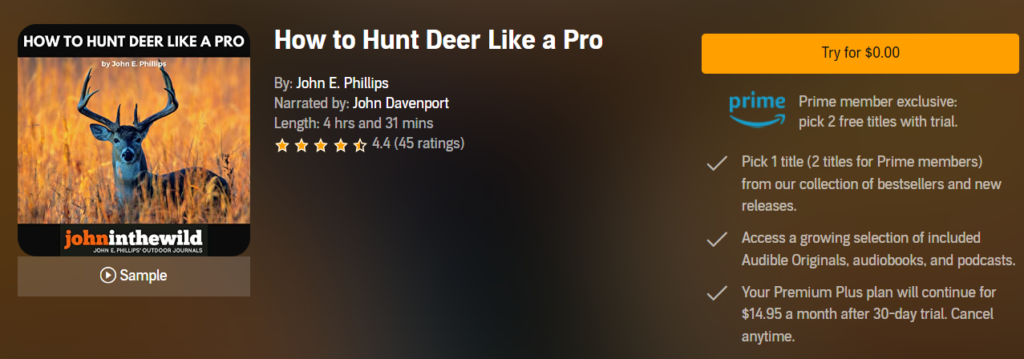
Prime Members: You’re eligible to claim 2 free titles with your 30-day Audible Premium Plus trial! Browse more than 100 of John E. Phillips’ expert guidebooks on hunting and fishing here.
Books By Topic
Category Shortcuts: View on Amazon
| Deer Hunting | Turkey Hunting | Elk Hunting | Bass Fishing |
| Mule Deer Hunting | Bowhunting | Bowfishing | Crappie Fishing |
| All Cookbooks | Hunting Cookbooks | Fishing Cookbooks | All Audible Books |
Expert Guidebooks on Elk Hunting: Best Sellers

Secrets for Hunting Elk
The quickest, easiest (if there is an easy way), and safest way to find and take that bull elk of a lifetime will be to hunt with a guide.
Chad Schearer, a longtime Montana guide and TV personality, told me, “My hunter is my gun. If I get to the elk, and my hunter isn’t with me, then we don’t take the elk. My job is not only to find the elk but also to help the hunter get to the elk and make the experience as enjoyable as I can for him.” That’s the kind of fella with whom I want to go elk hunting.
An elk hunt can be tough, but it doesn’t have to be so tough that you don’t enjoy it. That’s why this elk hunting book starts with the confessions of an elk guide and with Chad Schearer’s philosophy of what the guide and the hunter’s relationship should be.
A good portion of your success will depend on your physical condition, and Matt Morrett of Harrisburg, Pennsylvania explains how an eastern hunter can get ready physically during June and July to hunt western elk, the animals he describes as, “Like deer or turkeys on steroids.”
Wayne Carlton, well-known elk hunter and TV and video personality from Montrose, Colorado, tells us what types of elk calls to use and what to say to the elk. Mike Miller of Colorado, another elk guide and Mossy Oak video personality, has tactics for the best equipment for bowhunting and gun hunting elk.
You’ll learn helpful strategies and hunting tips in this book, as well as some straightforward hunting methods that will help to make your elk hunt more successful.
“Thanks to the advice in your elk hunting books, I was able to call up a nice 6-point (6X6) bull elk! He was bugling like crazy. I called him in from about a ¼ mile away. Called him into bow range (about 40 yards away). It was a thrill!” ~Rob Brannon
VERSIONS: AUDIBLE & KINDLE

Elk: Keys to 25 Hunters’ Success
Often just one tip or tactic makes the difference in whether you take an elk home to dinner or have to hike back to the truck by yourself. In John E. Phillips’ latest elk book, Elk: Keys to 25 Hunters’ Success, you’ll learn from successful elk hunters the strategies they use to find and take elk.
Many know that the technique that seems to work most often is to hunt where other elk hunters don’t and understand where the elk are before you go on a hunt by studying data from each state, visiting HuntData (see chapter 1), examining maps, and reading postings on elk forums.
This book also tells you how to get ready physically for an elk hunt, including participating in Train to Hunt Competitions, what gear you need to take, how to enjoy a successful do-it-yourself elk hunt, or how to pick the best elk guide for you. You’ll also hear about the X System and the Broken Y System of hunting elk.
Although no one person has all the answers on how to help you find and take your elk, I’m convinced that this book’s outdoors men and women will teach you how to have satisfying elk hunts.
As my friend Karl Badger once told me, “Elk hunting doesn’t get any better than when I ride horses into the high backcountry, see two grizzly bears, hear a pack of wolves howl close to camp all night long, eat plenty of delicious food prepared on a fire and enjoy the company of good friends.”
VERSIONS: AUDIBLE, KINDLE & PRINT

How to Find Your Elk and Get Him in Close will teach you the tactics of 10 nationally known elk hunters, to help put that giant bull that’s been screaming at you from afar, in your lap. You’ll learn what some of the best guides, outfitters, and successful elk hunters do to find elk and get them in really close.
Also in this audiobook, you’ll notice that the majority of the experts call elk to within bow range. We selected numerous bowhunters and bowhunting guides, since the bowhunter has to get much closer to a bull than the gun hunter does – often less than 20 or 30 yards – practically in your lap.
On one elk hunt, I’d heard this bull bugle all morning. My guide had called him within 30 yards, and he was standing just inside black timber. I saw the smoke from his nose wafting out into the icy air less than 30-yards away. All the bull had to do was step out, and I could take the shot with my bow. But then, through no fault of my guide or me, the bull vanished.
The only conclusion I could come up with to understand why the bull I wanted to take with my bow hadn’t stepped out and given me a shot, was because he got raptured. He evidently had left the earth with no trace of himself.
This hunt was when I started wanting to learn more about hunting elk up close. In this book, I’ve tried to find some of the most knowledgeable, experienced, and practical elk hunters. I’ve always found that the best way to learn any outdoor skill, is to either hunt or fish with the best sportsmen in that field.
Often, in elk hunting, that means elk guides, who generally hunt every day of the season and receive a salary for every hunter they guide. So, I’ve put together a group of some of the best elk hunters I know to help us all learn how to find bull elk and get them in close.
VERSIONS: AUDIBLE, KINDLE & PRINT

